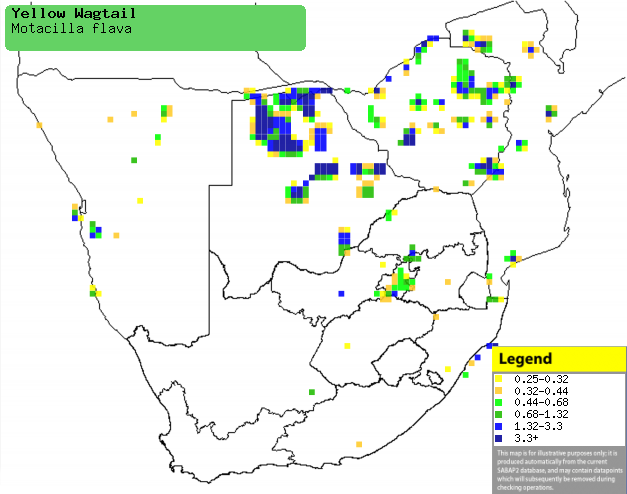|
Motacilla flava (Yellow
wagtail)
Geelkwikkie [Afrikaans]; Russische gele kwikstaart [Dutch];
Bergeronnette printanière [French]; Schafstelze [German];
Alvéola-amarela [Portuguese]
Life
> Eukaryotes >
Opisthokonta
> Metazoa (animals) >
Bilateria >
Deuterostomia > Chordata >
Craniata > Vertebrata (vertebrates) > Gnathostomata (jawed
vertebrates) > Teleostomi (teleost fish) > Osteichthyes (bony fish) > Class:
Sarcopterygii (lobe-finned
fish) > Stegocephalia (terrestrial
vertebrates) > Tetrapoda
(four-legged vertebrates) > Reptiliomorpha > Amniota >
Reptilia (reptiles) >
Romeriida > Diapsida > Archosauromorpha > Archosauria >
Dinosauria
(dinosaurs) > Saurischia > Theropoda (bipedal predatory dinosaurs) >
Coelurosauria > Maniraptora > Aves
(birds) > Order: Passeriformes
> Family: Motacillidae > Genus: Motacilla
Distribution and habitat
Breeds from Europe and northern Africa through Asia to
Alaska and north-western Canada, migrating south in the non-breeding season to
India, south-east Asia, Australia and sub-Saharan Africa, from Senegal to
Somalia south to southern Africa. Here it is fairly common in patches of
Zimbabwe, Mozambique, Namibia, Botswana (especially the Okavango Delta) and
South Africa, mainly in Gauteng Province. It generally prefers moist areas, such
as the edges of pans, vleis, sewage works and exposed mudbanks, also occurring
in cane fields and dry plains near water.
|
 |
|
Distribution of Yellow wagtail in southern Africa,
based on statistical smoothing of the records from first SA Bird Atlas
Project (©
Animal Demography unit, University of
Cape Town; smoothing by Birgit Erni and Francesca Little). Colours range
from dark blue (most common) through to yellow (least common).
See here for the latest distribution
from the SABAP2. |
Movements and migrations
Non-breeding migrant to southern Africa,
arriving in the period from October-November in the north and
November-December in the south, leaving in small flocks from
March-April throughout the region.
Food
Its diet in southern Africa has not been studied, however
in Nigeria it eats insects and other invertebrates, foraging on the ground and
in the air. The following food items have been recorded
in its diet in Nigeria:
Threats
Not threatened.
References
-
Hockey PAR, Dean WRJ and Ryan PG 2005. Roberts
- Birds of southern Africa, VIIth ed. The Trustees of the John Voelcker
Bird Book Fund, Cape Town.
|
